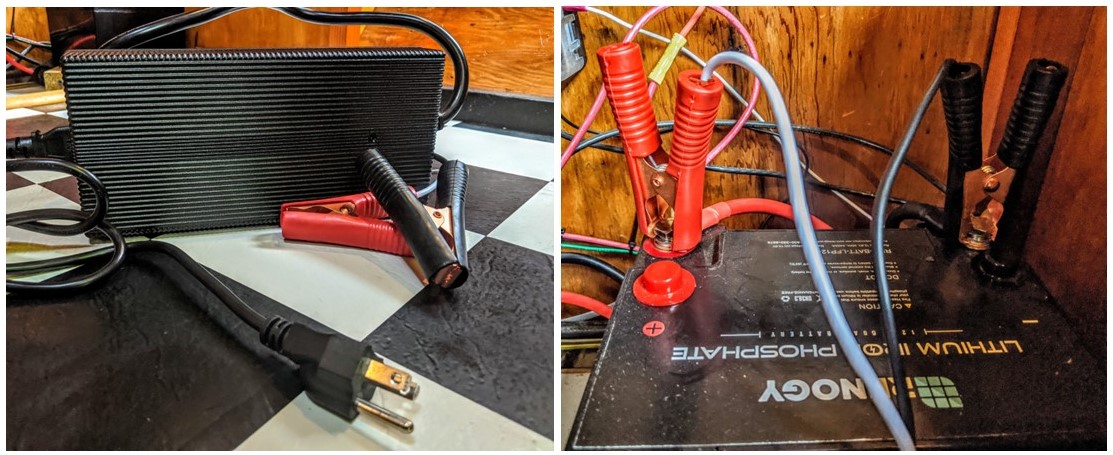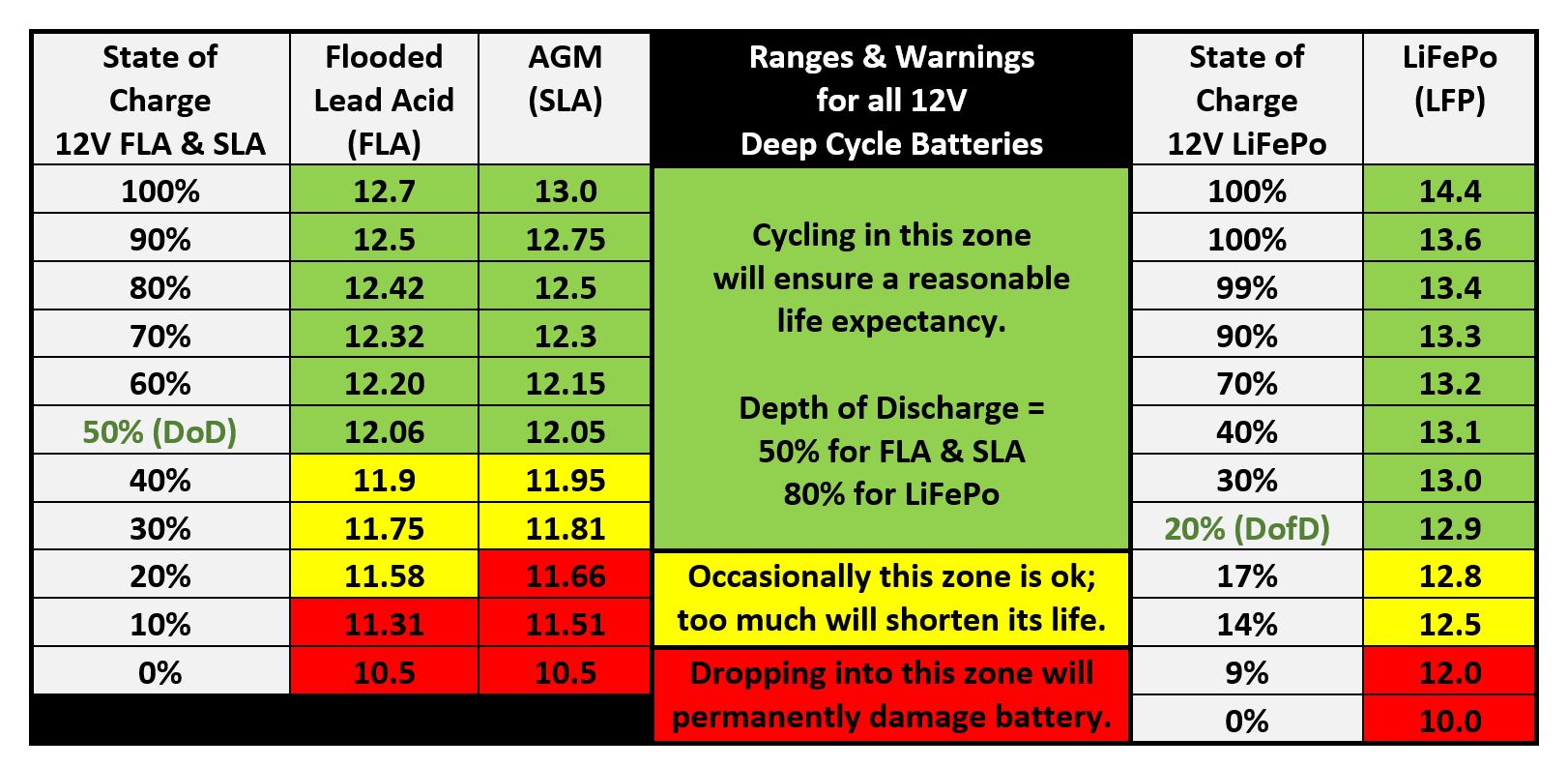How to Charge a Lithium Battery?
How Do Lithium-ion Batteries Work?
Lithium-ion batteries are used in a variety of settings, from cell phones, watches, and laptops to portable solar chargers and electric vehicles. They are used in various electronic devices because they are lightweight, can be charged & discharged numerous times, and are very long lasting. They offer what is known as a “flat discharge curve,” which means they can provide a consistent source of power over a longer period of time as compared to conventional batteries. This means that Lithium delivers the same output throughout the discharge cycle, whereas Lead Acid batteries decrease their output as they discharge.
Lithium-ion batteries are made of lightweight Lithium and Carbon, and contain an electrolyte solution. The movement of ions through the electrolyte solution is what causes the electrons to move through the device that is connected to the battery. When recharging, the lithium ions simply go through the same process, but in the opposite direction.
Lithium Iron Phosphate (aka LiFePO4 or LFP batteries) are a type of lithium-ion battery, but are made of a different chemistry, using lithium ferro-phosphate as the cathode material. LiFePO4 batteries have the advantages of long cycle life, a high charge and discharge rate, a low self-discharge rate, high safety, high energy density, and high-temperature performance. As a result of these benefits, these batteries are used in solar powered system installations in homes, RV’s, boats, and more.
What is a Battery Charger?
Lithium battery chargers come in a variety of styles and can either be built-in to your system or just portable, depending on your needs. Read on to learn about the various charging methods you can use that are compatible with lithium batteries. It’s smart to have a couple of different charging options handy so that you can recharge using the energy source you have available!
How to Charge Lithium-ion (or LiFePO4) Batteries?
There are several ways to charge Lithium batteries – using solar panels, a DC to DC charger connected to your vehicle’s starting battery (alternator), with an inverter charger, or with a portable 12V battery charger or 24V battery charger.
While charging LiFePO4 batteries with solar is perfect for sunny days, you can complement this by charging lithium batteries with the alternator of your vehicle while driving, or with an inverter charger or portable battery charger when plugged into an electrical outlet at home or at a campsite. You can even combine 2 charging methods at once, allowing you to charge up your lithium batteries even faster! Let’s discuss each of these methods in detail…
Using Solar Panels: Charging lithium batteries with solar panels is the most energy efficient method as you are simply using the power of the sun. You’ll need both solar panels and an appropriately-sized solar charge controller which can be installed on any RV, home, boat, or van.

Using a DC to DC Charger: You can charge a Lithium battery with a vehicle alternator by using a DC to DC charger. This device pumps up the excess voltage coming from the alternator and charges your RV/van house battery while you are driving. With a dual input DC to DC charger, you can take advantage of both solar gain AND the trickle charge from your vehicle’s alternator simultaneously.
We started using this method for our own mobile life and it has been a game changer for boondocking. Check out our step-by-step installation video here. In addition, this blog will walk you through how to size a DC to DC charger that will fit with your system’s specs and parameters.
Using an Inverter Charger: By installing an inverter charger, you can charge your Lithium batteries when you have access to a 15-20A outlet at home or at a campground with electrical hook-ups. Just plug in your RV as you normally would and the inverter charger does all the work! This is the most expensive option, but it’s also very convenient. Sizing and installing an inverter charger is simple, just follow the steps in this blog.
Using a Solar Lithium Battery Charger: This small, portable device can be used for charging lithium batteries. We only need to charge our LiFePO4 battery off of AC power 1 or 2 times per year, usually when we have many days with low solar gain. We use this method in our small camper when we have access to a 15-20A outlet at a friend’s house or at a campground with electrical hook-ups. It sure comes in handy after a week of rain, snow, or cloudy weather especially if we haven’t been driving!

Lithium battery charging with a solar lithium battery charger is very straightforward. Clip the alligator clips to the appropriate battery terminals (red clip to red/positive terminal and black clip to black/negative terminal), position the charger as far away from the batteries as you can (making sure it is NOT sitting above the battery bank), and plug in the other end to any AC outlet providing 15-20A of power. See our how to video for details.
Renogy makes 2 different LiFePO4 battery solar chargers. The one you need depends on the voltage of your battery bank. The 20A AC-to-DC Charger is designed for use with any 12V Lithium Iron Phosphate battery. Alternatively, the 24V 10A AC-to-DC Charger is designed for use with 24V systems such as a 24V 25Ah LFP battery.
To see a step-by-step installation video which incorporates three seamless methods of charging (via engine, solar and AC power source), into one powerful plug and play off-grid system, view our Renogy REGO Installation Playlist here.
Can I Charge a Lithium Battery with a Normal Battery Charger?
The short answer is, no. Lithium batteries operate at a higher voltage range than conventional batteries. At 100% charge, a flooded lead acid will have a voltage of 12.8V, an AGM 13.0V and LiFePo 14.4V. The battery charging parameters correspond to the battery voltage range. Learn more about deep cycle battery voltages.

Do I Need a Special Charger for Lithium Batteries?
Some battery chargers have different settings for different batteries, including settings for lithium. With the higher voltage parameters of lithium batteries, the charger has to be able to produce an efficient battery charging current. Lithium batteries also have a lower internal resistance than conventional batteries, which means that they charge differently and faster, so connecting a normal charger to a lithium battery could ultimately damage it.
Can I Charge a Lithium Battery with an AGM charger?
Even though AGM batteries have a slightly higher voltage than flooded lead acid, an AGM charger is not appropriate to use with any lithium battery.
How to Charge a Lithium Ion Battery without a Charger?
As described earlier in this article, charging lithium batteries can be achieved either by a solar panel array through a solar charge controller, or a vehicle engine charge from the starting battery through a DC to DC charger. Renogy also offers a dual input DC to DC charger that combines the solar and engine charging inputs into one convenient charger. This option is not only ideal for vans and other Class C motorhomes, but they can also be installed between towing vehicles and travel trailers or 5th wheels using wires and easy to hook-up Anderson connectors.
How Long Do Rechargeable Batteries Last?
How long a battery lasts will depend on how many cycles you use over time. Any deep cycle battery is rechargeable, and designed to reliably deliver an electrical current until it reaches its safe depth of discharge (D.O.D) and then be recharged back up to 100%. Each one of these discharge-charge trips is called a cycle. Different battery types can handle more cycles than others. Learn more about the differences between the 4 major types of deep cycle batteries.

Since the number of cycles vary so widely between the types of batteries, and use of these batteries will vary between users, we need a baseline comparison. If we assume that we use one complete cycle per day, we can assume the following lifespan of each battery type. If you don’t use a full cycle every day, the battery will last longer. However, it is clear that no matter the type of lithium battery, they significantly outlast other deep cycle batteries.

*Most Renogy LiFePo batteries have a life cycle range between 3500-4000, only the 12V 100AH LiFePo Battery with built-in BT Module is rated at 2000 cycles and is consequently the least expensive model in their LiFeP04 line.
What’s the Best LiFePO4 Battery Charger?
As we’ve discussed throughout this blog, the best charger for Lithium batteries is one that is specifically designed to provide lithium charging parameters. Renogy DC to DC chargers as well as solar charge controllers all have settings to work with LiFeP04 batteries. Renogy offers two models of AC-to-DC Battery Chargers that only work with LiFeP04 Batteries, 12V and 24V.

In 2012, Shari Galiardi & David Hutchison left behind careers and a comfortable home in North Carolina to travel with the vintage camper trailer they lovingly restored, outfitted with solar, and named "Hamlet." What began as a short break from careers and responsibility quickly turned into a love affair with roadlife. They have parlayed their higher education backgrounds, desire for life-long learning, and thirst for adventure travel into writing, photography, video production, and public speaking gigs from coast to coast. Known to their friends as simply Shari & Hutch, you can learn more about their full-time, solar-powered adventures on their website at freedominacan.com. Or, follow them on Facebook, Instagram, and YouTube as “Freedom in a Can, LLC.”
Related articles:
How To Store Lithium Batteries & Care Of Lithium Batteries
Are Lithium Ion Batteries Dangerous And What Are The Safest Lithium Batteries?
Product Review: 50 Amp Lithium Iron Phosphate Battery
Bluetooth Lithium Iron Phosphate Batteries For Solar: Everything You Need To Know








